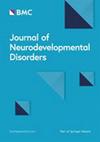Assessing receptive verb knowledge in late talkers and autistic children: advances and cautionary tales
IF 4.1
2区 医学
Q1 CLINICAL NEUROLOGY
引用次数: 0
Abstract
Using eye-tracking, we assessed the receptive verb vocabularies of age-matched late talkers and typically developing children (experiment 1) and autistic preschoolers (experiment 2). We evaluated how many verbs participants knew and how quickly they processed the linguistic prompt. Our goal is to explore how these eye-gaze measures can be operationalized to capture verb knowledge in late talkers and autistic children. Participants previewed two dynamic scenes side-by-side (e.g., “stretching” and “clapping”) and were then prompted to find the target verb's referent. Children’s eye-gaze behaviors were operationalized using established approaches in the field with modifications in consideration for the type of stimuli (dynamic scenes versus static images) and the populations included. Accuracy was calculated as a proportion of time spent looking to the target, and linguistic processing was operationalized as latency of children’s first look to the target. In experiment 1, there were no group differences in the proportion of verbs known, but late talkers required longer to demonstrate their knowledge than typically developing children. Latency was predicted by age but not language abilities. In experiment 2, autistic children’s accuracy and latency were both predicted by receptive language abilities. Eye gaze can be used to assess receptive verb vocabulary in a variety of populations, but in operationalizing gaze behavior, we must account for between- and within-group differences. Bootstrapped cluster-permutation analysis is one way to create individualized measures of children’s gaze behavior, but more research is warranted using an individual differences approach with this type of analysis.评估晚说话儿童和自闭症儿童的接受性动词知识:进步与警示故事
我们使用眼动跟踪技术,评估了与年龄相匹配的晚说话儿童和发育正常儿童(实验 1)以及自闭症学龄前儿童(实验 2)的接受性动词词汇量。我们评估了参与者知道的动词数量以及他们处理语言提示的速度。我们的目标是探索如何利用这些眼动测量来捕捉说话较晚儿童和自闭症儿童的动词知识。参与者并排预览两个动态场景(如 "伸展 "和 "鼓掌"),然后在提示下找到目标动词的所指。儿童的注视行为采用该领域的既定方法进行操作,并根据刺激类型(动态场景与静态图像)和所包含的人群进行了修改。准确率按注视目标所花时间的比例计算,语言处理按儿童首次注视目标的延迟时间计算。在实验 1 中,已知动词的比例没有组间差异,但晚说话的儿童比发育正常的儿童需要更长的时间来展示他们的知识。延迟时间受年龄而非语言能力的影响。在实验 2 中,自闭症儿童的准确率和延迟时间都是由接受语言能力预测的。目光注视可用于评估各种人群的接受性动词词汇量,但在操作注视行为时,我们必须考虑到组间和组内差异。引导聚类畸变分析是对儿童注视行为进行个体化测量的一种方法,但我们还需要利用个体差异法对这种分析方法进行更多的研究。
本文章由计算机程序翻译,如有差异,请以英文原文为准。
求助全文
约1分钟内获得全文
求助全文
来源期刊
CiteScore
7.60
自引率
4.10%
发文量
58
审稿时长
>12 weeks
期刊介绍:
Journal of Neurodevelopmental Disorders is an open access journal that integrates current, cutting-edge research across a number of disciplines, including neurobiology, genetics, cognitive neuroscience, psychiatry and psychology. The journal’s primary focus is on the pathogenesis of neurodevelopmental disorders including autism, fragile X syndrome, tuberous sclerosis, Turner Syndrome, 22q Deletion Syndrome, Prader-Willi and Angelman Syndrome, Williams syndrome, lysosomal storage diseases, dyslexia, specific language impairment and fetal alcohol syndrome. With the discovery of specific genes underlying neurodevelopmental syndromes, the emergence of powerful tools for studying neural circuitry, and the development of new approaches for exploring molecular mechanisms, interdisciplinary research on the pathogenesis of neurodevelopmental disorders is now increasingly common. Journal of Neurodevelopmental Disorders provides a unique venue for researchers interested in comparing and contrasting mechanisms and characteristics related to the pathogenesis of the full range of neurodevelopmental disorders, sharpening our understanding of the etiology and relevant phenotypes of each condition.

 求助内容:
求助内容: 应助结果提醒方式:
应助结果提醒方式:


